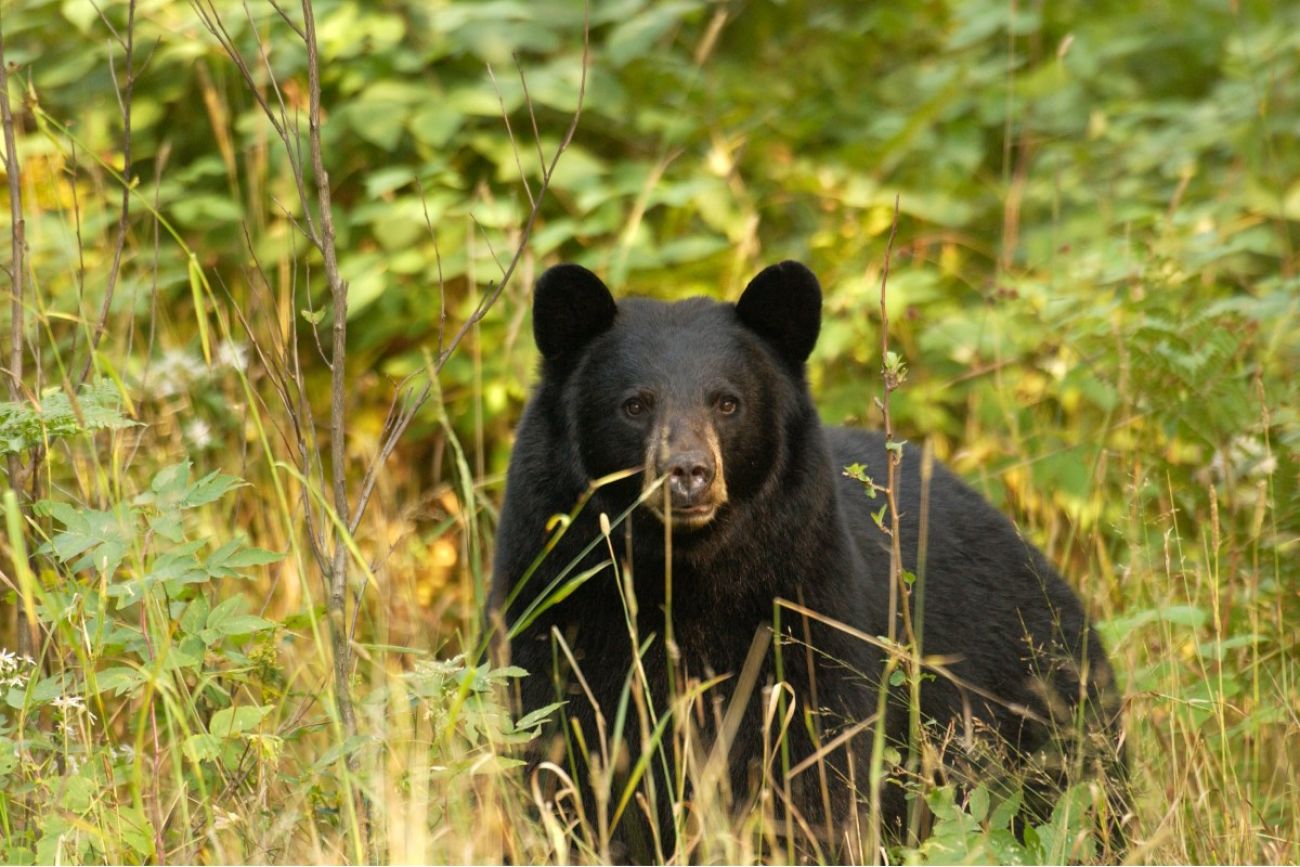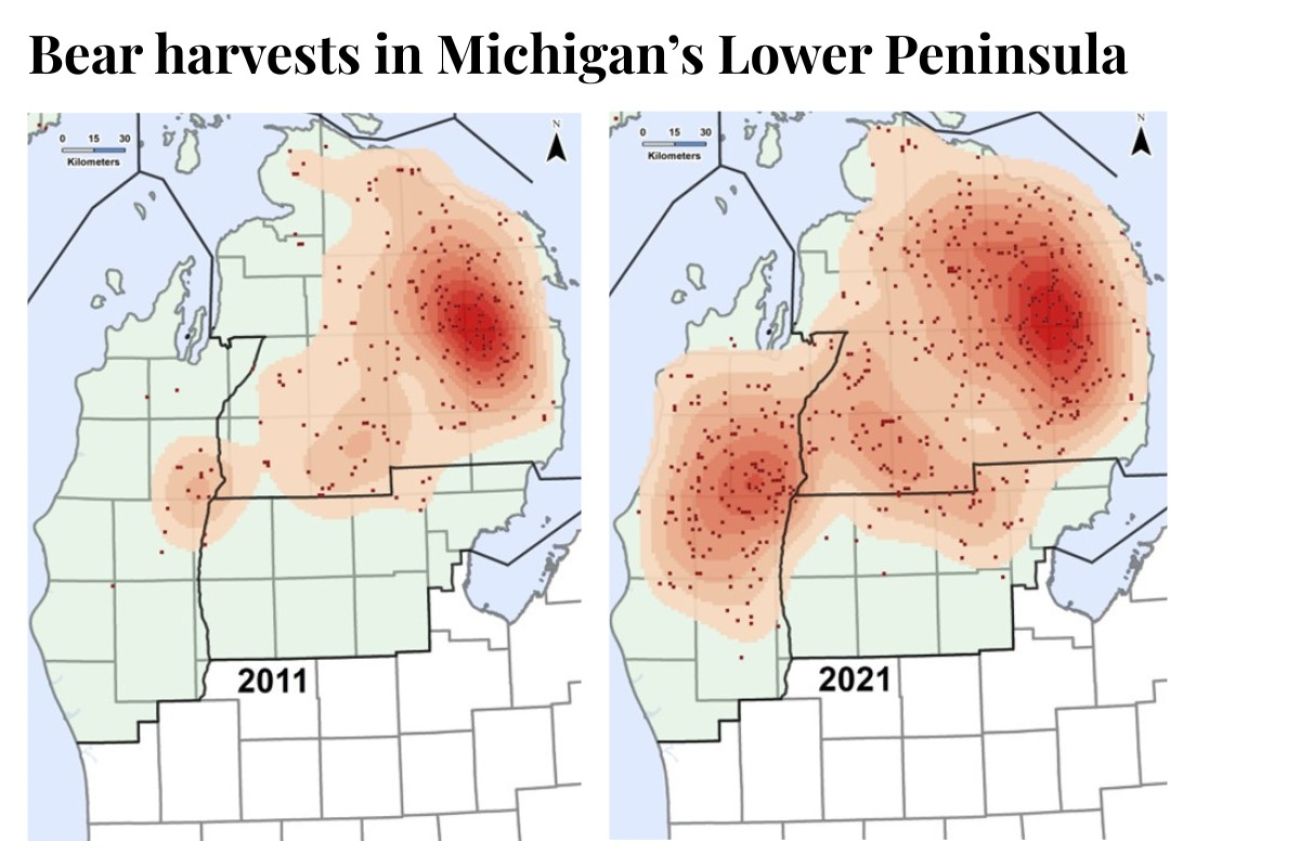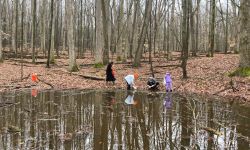Michigan bears on the move, popping up in Gaylord, Traverse City, Glen Arbor

- Michigan has about 13,000 bears, all American black bears
- The bear population in Michigan’s Lower Peninsula, about 1,700, is growing and expanding southwest
- Bear sightings in the Lower Peninsula are commonly reported in destinations like Petoskey, Charlevoix, Gaylord, Traverse City and Glen Arbor
About three weeks ago, at Traverse City shop TC Butchering, someone brought in a 435-pound black bear that had been hit by a car.
“The lady that hit the bear did not want the bear and she gave it to somebody else,” said shop owner Terry Conger. “That person brought it to me to be processed.”
The butcher and slaughter shop prepares bears during hunting season, but Conger said that was the first time in his 20 years he’d had someone bring in a bear that had been road kill.
Then, on Thursday, it happened again: Another roadkill bear came into his shop.
According to the Michigan Department of Natural Resources, about 13,000 bears live in Michigan, all of them American black bears. The vast majority, around 11,000, live in the Upper Peninsula. About 1,700 live in the northern Lower Peninsula.
While smaller, the Lower Peninsula’s bear population has increased at a faster rate than the UP’s and the animals have a growing footprint.
For decades, most bears in the Lower Peninsula lived in the northeast corner, outside Alpena, where there’s a lot of private, undeveloped land that’s not easily accessible to the public. The population there started growing after hunting restrictions were put in place in 2012.
Since then, some bears from the area started moving out.
“Bears that are born there, when they reach the age of maturity, especially males, they've been shown to leave their natal home range, disperse out and end up in all the other areas of the Lower Peninsula where we see bears,” said Cody Norton, a bear specialist with DNR.

RELATED:
- Cocaine Bear? In Michigan, it's melatonin bear
- Deer are running amok in suburban Michigan. Is it time to shoot them?
- Groups sue Michigan wildlife regulators over shorter coyote hunting season
The adolescent bears have headed southwest, adding to and expanding out from existing populations in Wexford and Roscommon counties. As the footprint has grown, bears are now commonly spotted in destinations like Petoskey, Charlevoix, Gaylord, Traverse City and Glen Arbor.
And, in turn, the DNR is receiving an increased number of bear complaints.
"When we think about the northwestern Lower Peninsula,” Norton said, “we've got a lot of people living there that haven't typically had bears.”
Sign up for our outdoors newsletter
Bridge Michigan is investing in more coverage about Michigan's great outdoors with the launch of a newsletter in the next few weeks. Let us know what your interests are, what you want from a newsletter and be one of the first to subscribe. Sign up here.
Most years, the DNR receives about 285 bear complaints. Last year, the department received 303 complaints. While many came from counties in the Upper Peninsula, some Lower Peninsula counties also reported a high number of bear complaints: Otsego County had 26 bear complaints, Charlevoix County had 19, Leelanau County had 16 and Grand Traverse County had 13.
One of the bear sightings last year was caught on video. A small black bear was seen climbing a tree and galloping across the parking lot of a mall in Traverse City.
Keeta Beaubien, a resident of Inland Township about 20 miles south of Traverse City, has had her fair share of bear action. She and her husband used to keep bird seed in a box on their deck, but it turned out to be a magnet for bears.
“They have woken me up usually in the middle of the night banging the deck box and dragging it down the steps,” Beaubien said. “Only once did one ever get nasty. He stood on his hind legs and growled at me, but even he took off when I yelled and waved my arms at him.”
Now that Beaubien’s family has a garage they can store bird seed in and they try to bring feeders in at night, they don’t have as many issues with bears.
“Bear activity and bear conflicts, for the vast majority, revolve around food,” said the DNR’s Norton. “Bears are extremely food-motivated. They have six months of the year in some parts of Michigan to be able to pack on all of the fat, all the nutrients that they're going to need to make it through the entire year.”

Especially right now, while bears in the state are still emerging from hibernation, Norton recommends residents living in bear country reduce food sources and smells by switching bird feeders out with bird baths, only put garbage out the morning of pick-up, and clean barbecue grills after use.
Though bear nuisance reports in some areas have gone up while more residents adjust to living with bears, Norton has this take: “It's a success story, right? We've got bears recolonizing or moving into areas that are good bear habitat.”
Bears bring a lot to the areas they live in. As omnivores, they help keep small mammal and insect populations in check. They recycle nutrients back into the environment when they eat decaying dead animals. And spotting their scat doesn’t just mean a bear might be nearby, it means bears are spreading seeds for fruit, berries and nuts, and, in turn, are helping to promote plant growth and forest regeneration.
See what new members are saying about why they donated to Bridge Michigan:
- “In order for this information to be accurate and unbiased it must be underwritten by its readers, not by special interests.” - Larry S.
- “Not many other media sources report on the topics Bridge does.” - Susan B.
- “Your journalism is outstanding and rare these days.” - Mark S.
If you want to ensure the future of nonpartisan, nonprofit Michigan journalism, please become a member today. You, too, will be asked why you donated and maybe we'll feature your quote next time!




